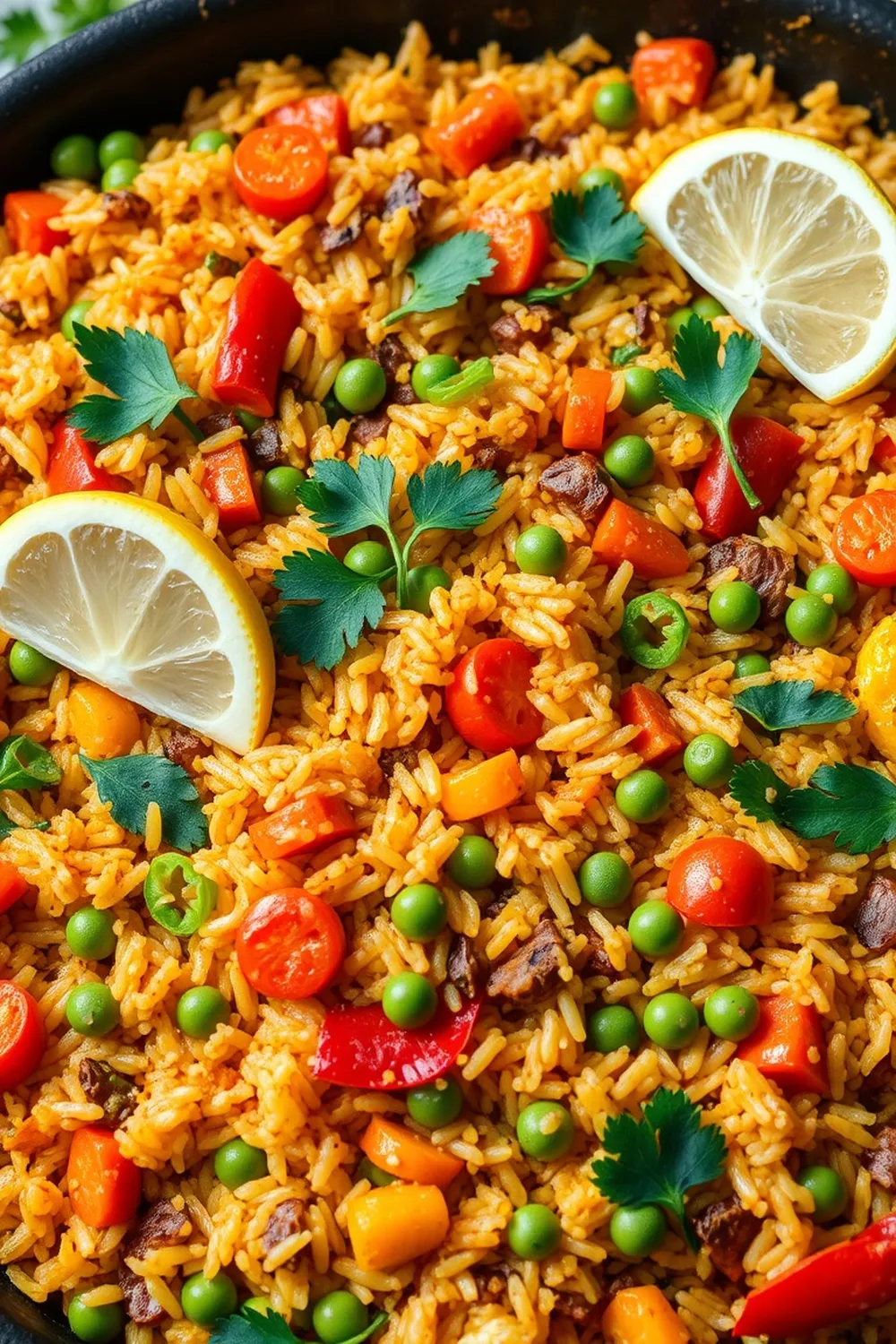- Heat oil in a deep pan over medium-low heat. Add cumin seeds, cinnamon stick, cloves, and cardamom pods. Toast until fragrant.
- Add sliced onions and sauté until lightly browned, ensuring they don’t burn.
- Pour in water, season with salt, and bring to a gentle boil. Stir in rinsed basmati rice, reduce heat to low, cover, and cook until rice is tender and water is absorbed (about 15-20 minutes).
- Fluff rice with a fork, garnish with fresh coriander leaves, and serve warm.
- Calories:220 kcal25%
- Energy:920 kJ22%
- Protein:4 g28%
- Carbohydrates:40 mg40%
- Sugar:1 mg8%
- Salt:200 g25%
- Fat:4.5 g20%
Last Updated on 4 months by Neha Deshmukh
Authentic Basmati Rice Recipe – Cumin & Cinnamon Flavored
Introduction
There’s just something magical about a perfectly cooked pot of Basmati rice, isn’t there? It’s the foundation of so many incredible Indian meals, and honestly, it’s a comfort food all on its own. I remember learning to make this from my nani (grandmother) – she always said the secret was in the spices. This recipe is a tribute to her, and I’m so excited to share it with you. It’s simple, fragrant, and guaranteed to elevate your next meal.
Why You’ll Love This Recipe
This isn’t just any Basmati rice recipe. The gentle infusion of cumin and cinnamon transforms simple rice into something truly special. It’s incredibly easy to make, even if you’re new to Indian cooking. Plus, it’s a fantastic base for curries, dals, or even just a simple yogurt-based raita. You’ll love how the aroma fills your kitchen!
Ingredients
Here’s what you’ll need to create this flavorful rice:
- 2 tbsp light cooking oil
- 1 tsp cumin seeds
- 1 cinnamon stick
- 3-4 cloves
- 3-4 green cardamom pods
- 1 medium onion
- 5 cups water (approximately 1200ml)
- 2.5 cups Basmati rice (approximately 375g)
- Salt to taste
- Fresh coriander leaves, for garnish
Ingredient Notes
Let’s talk ingredients – a few little things can make a big difference!
- Basmati Rice: Choosing the Right Grain Basmati rice is key here. Look for aged Basmati – it’s longer, fluffier, and has a more pronounced aroma. I prefer the extra-long grain variety.
- Spices: The Significance of Cumin, Cinnamon, Cloves & Cardamom These aren’t just for flavor! In Ayurveda, these spices are believed to aid digestion. The combination creates a warm, inviting fragrance that’s classic in Indian cuisine. Don’t skimp on them!
- Oil: Selecting a Light Cooking Oil A neutral oil like sunflower or canola works best. You want something that won’t overpower the delicate flavors of the spices. I sometimes use ghee for an extra touch of richness, especially for festive occasions.
Step-By-Step Instructions
Alright, let’s get cooking!
- Heat the oil in a deep pan or pot over medium-low heat. Once it’s warm, add the cumin seeds, cinnamon stick, cloves, and cardamom pods. Let them toast for about 30-60 seconds, until they become fragrant. Be careful not to burn them!
- Now, add the sliced onion and sauté until it’s lightly browned. This takes about 5-7 minutes. Don’t rush this step – the browned onions add a lovely sweetness to the rice.
- Pour in the water and season with salt. Bring it to a gentle boil. Then, add the rinsed Basmati rice. Give it a quick stir, reduce the heat to low, cover the pot tightly, and let it cook undisturbed for 15-20 minutes.
- Once the water is absorbed and the rice is tender, fluff it gently with a fork. Garnish with fresh coriander leaves and serve warm.
Expert Tips
A few little secrets to perfect rice:
- Rinsing is Key: Always rinse your Basmati rice under cold water until the water runs clear. This removes excess starch and prevents the rice from becoming sticky.
- Low and Slow: Cooking the rice on low heat is crucial. This ensures it cooks evenly and doesn’t burn.
- Don’t Peek! Resist the urge to lift the lid while the rice is cooking. This releases steam and can affect the cooking process.
Variations
Want to switch things up? Here are a few ideas:
- Spice Level Adjustments: If you like a little heat, add a pinch of red chili powder along with the salt.
- Regional Variations (e.g., adding bay leaf): My friend’s mother always adds a bay leaf to her rice – it adds a subtle, aromatic flavor. Feel free to experiment!
- Festival Adaptations (e.g., serving with Biryani): This rice is a wonderful accompaniment to Biryani. You can also add a few saffron strands to the water for a vibrant color and luxurious flavor, perfect for special occasions.
Serving Suggestions
This rice is incredibly versatile! It pairs beautifully with:
- Dal Makhani
- Butter Chicken
- Vegetable Curry
- Raita
- Or simply enjoyed on its own!
Storage Instructions
Leftover rice can be stored in an airtight container in the refrigerator for up to 3 days. Reheat gently with a splash of water to prevent it from drying out.
FAQs
Let’s answer some common questions:
- What is the best way to rinse Basmati rice? Place the rice in a fine-mesh sieve and rinse under cold running water until the water runs clear. Gently swirl the rice with your hand.
- Can I use a different type of rice for this recipe? While Basmati is preferred, you can use long-grain white rice in a pinch. However, the texture and flavor won’t be quite the same.
- How do I prevent the rice from sticking to the bottom of the pan? Using a heavy-bottomed pot and cooking on low heat helps prevent sticking. Also, ensure you’ve rinsed the rice thoroughly.
- What if I don’t have all the whole spices? Can I use powdered spices? Whole spices are always best for flavor, but if you only have powdered spices, you can use about 1/2 teaspoon of each (cumin powder, cinnamon powder, clove powder, cardamom powder).
- How can I tell when the rice is perfectly cooked? The rice should be tender and fluffy, and all the water should be absorbed. If it’s still a little hard, add a tablespoon or two of water and cook for a few more minutes.










